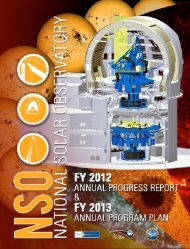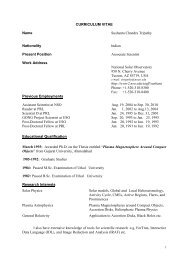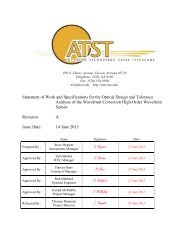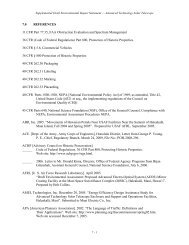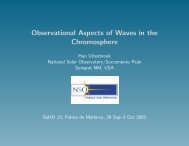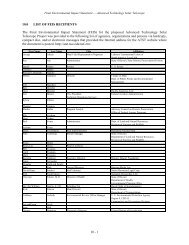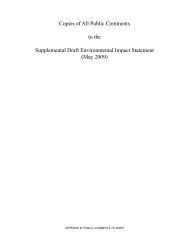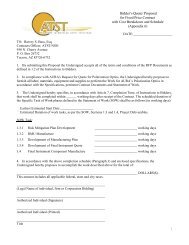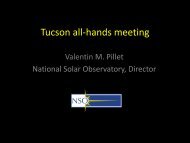F2 - ATST
F2 - ATST
F2 - ATST
You also want an ePaper? Increase the reach of your titles
YUMPU automatically turns print PDFs into web optimized ePapers that Google loves.
Cultural Surveys Hawai‘i Job Code: HALEA 2Archaeological Research4.1.6 Hanakauhi GroupEmory relied on the testimony of Robert T. Aitken for information regarding a set ofstructures resident at Hanakauhi Valley. Three stacked-basalt platforms and two stacked-basaltahus were observed “in a little pocket lying between Mamani and Kumu Hills”. The threeplatforms, which were situated respectively in the south, east, and north parts of the valley werenotable for volcanic “bombs” [cobble-sized basalt ejecta with a characteristic teardrop shape:first described as a “bombe de roulement” by J. D. Dana, Manual of Geology, 4 th ed.,1894:287]used in the construction. The isolated south platform was bordered by a wall less than 2 feethigh, forming a rectangle 15 ft by 7 ft. The east platform was recorded as poorly preserved, andthe north platform was noted with a secondary wall. The two ahus were recorded thus:Near the entrance to Hanakuhi Valley are two solidly built ahus constructed ofunmarked local stones. The north ahu measures 5 by 7 feet and the south ahu 5½by 9 feet; both are 2½ feet high and lie east and west. By standing on them thethree platforms in the valley can be seen and the approach to the valley watched(Emory 1921:13).4.1.7 Mamani GroupA group of eleven stacked-basalt platforms, some of which were examples with features newto Emory and his team, were recorded at the foot of Mamani crater, at a cinder cone namedKalua Mamani by native informants. A small terraced platform was noted on the west slope ofMamani crater, at the base of the cinder cone. It measured 12.5 ft by 4.5 ft by 1.5 ft high,oriented northeast/southwest. This platform was noted as “very similar to the lower terraces ofthe north and south Hanakauhi platforms, and its dimensions were the same as the east platform”(Emory 1921:14).An unusual square platform, located 200 ft southwest of the terraced platform describedabove, had been constructed on a raised knoll. It measured 4.5 ft on its north side, 6 ft on thesouth, 4.5 ft on the east and 6 ft on the west. It measured 1.5 ft high on the north and west, and2.5 ft high on the east and south, with shelves 2 ft wide.A structure comprised of slabs of aa clinker, stacked 1.5 ft tall in the form of a rectangle, waslocated 150 ft west of the square structure described above. The construction measured 3.5 ft by7 ft. This structure, and subsequent structures described below, were located on loose cinder atthe edge of an old lava flow issuing from a volcanic vent dubbed “Dante’s Inferno” by Emory.The structures were recorded in an orientation parallel to the edge of the lava flow: extending ina line northeast to southwest.At a location 100 ft further toward the southwest, a stacked-basalt structure was recorded thatdiffered markedly from previously recorded structures. The structure was constructed in a T-shape, the “T” measuring 3 ft square, joined eastward to a platform measuring 15 ft long by 5 ftwide by 2 ft high.Located 130 ft further to the southwest, a platform measuring 19.5 ft long by 3.5 ft wide by 2ft high was recorded.APPENDIX F (2): Supplemental Cultural Impact Assessment For the Proposed Advanced 40Technology Solar Telescope (<strong>ATST</strong>) at Haleakalā High Altitude ObservatoriesTMK (2) 2-2-07:008





